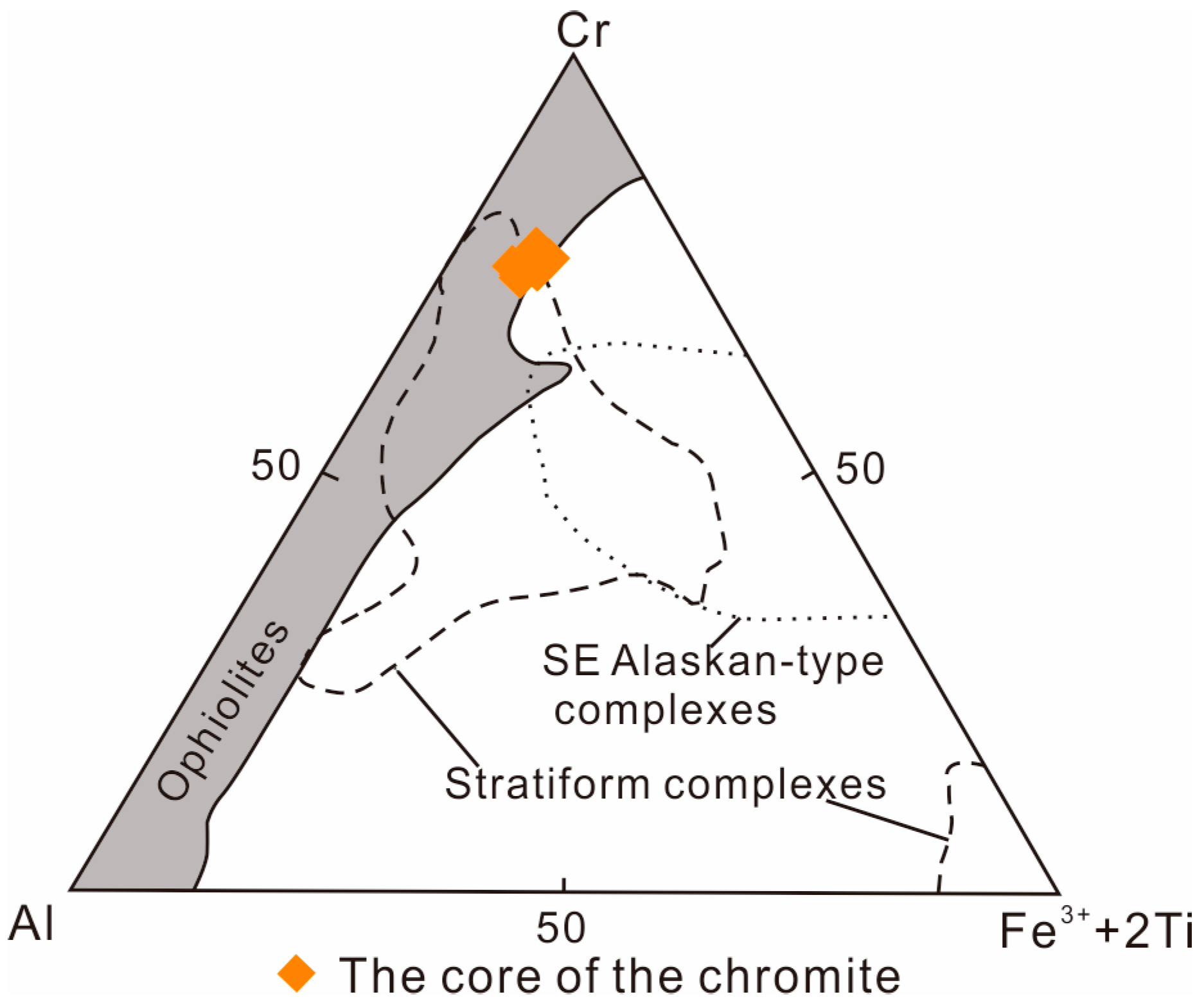The Genesis of Ultramafic Rock Mass on the Northern Slope of Lüliang Mountain in North Qaidam, China
Abstract
1. Introduction
2. Geological Setting
3. Petrography and Field Relations
4. Analytical Methods
5. Results
5.1. Major Element Characteristics of the Serpentinite
5.2. LA-ICP-MS Zircon U-Pb Dating
5.3. Mineral Chemistry of Chromite
6. Discussion
6.1. Characteristics of Protolith
6.2. Tectonic Environment
6.3. Physical and Chemical Conditions of Protolith
6.4. Petrogenesis

7. Conclusions
- The LA-ICP-MS analysis of zircon U-Pb dating on the serpentinite on the northern slope of Lüliang Mountain in the North Qaidam orogenic belt yields an age of 480.6 ± 2.4 Ma. These data indicate that the rock was formed during the northward subduction stage of the North Qaidam Ocean in the Ordovician period.
- The chromite within the ultramafic rock exhibits a distinct zonal texture. The core’s composition closely resembles that of the chromite end-member (FeCr2O4), with small amounts of spinel (MgAl2O4) and magnetite (FeFe2O4) components, representing the original chromite. It has high contents of Cr2O3 and Cr#. It is enriched in Fe3+# and depleted in Al2O3 and TiO2. The rim consists of Cr-rich magnetite exhibiting high Fe3+# contents while being depleted in Cr2O3, Al2O3, TiO2, and Cr#, indicating hydrothermal alteration.
- The ultramafic rock is classified as an ultramafic cumulate and is part of the ophiolite suite. It originated from the fore-arc deficit asthenosphere in a supra-subduction zone. Clear evidence of Fe-hydrothermal alteration is observed during the later uplift–denudation stage. The crystallization temperature of the ultramafic rock ranges from 1303 °C to 1308 °C, with an average value of 1306 °C, while the crystallization pressure ranges from 3.37 GPa to 3.46 GPa, with an average value of 3.41 GPa.
- In the North Qaidam orogenic belt, ultramafic cumulates containing abundant chromite, formed during the subduction stage of the North Qaidam Ocean, have significant potential for chromite-ore formation. Therefore, future ore prospecting efforts in the region should focus on these rock types.
Author Contributions
Funding
Data Availability Statement
Acknowledgments
Conflicts of Interest
References
- Song, S.G.; Su, L.; Niu, Y.L.; Zhang, G.B.; Zhang, L.F. Two Types of Peridotite in North Qaidam UHPM Belt and Their Tectonic Implications for Oceanic and Continental Subduction: A Review. J. Asian Earth Sci. 2009, 35, 285–297. [Google Scholar] [CrossRef]
- Song, S.G.; Niu, Y.L.; Su, L.; Zhang, C.; Zhang, L.F. Continental Orogenesis from Ocean Subduction, Continent Collision/Subduction, to Orogen Collapse, and Orogen Recycling: The Example of the North Qaidam UHPM Belt, NW China. Earth Sci. Rev. 2014, 129, 59–84. [Google Scholar] [CrossRef]
- Zhang, J.X.; Yu, S.Y.; Li, Y.S.; Yu, X.X.; Lin, Y.H.; Mao, X.H. Subduction, accretion and closure of Proto-Tethyan Ocean: Early Paleozoic accretion/collision orogeny in the Altun-Qilian-North Qaidam orogenic system. Acta Petrol. Sin. 2015, 31, 3531–3554. [Google Scholar]
- Yu, S.Y.; Zhang, J.X.; Sun, D.Y.; Pablo, G.D.R.; Li, Y.S.; Zhao, X.L.; Hou, K.J. Petrology, geochemistry, zircon U-Pb dating and Lu-Hf isotope of granitic leucosomes within felsic gneiss from the North Qaidam uhpterrane: Constraints on the timing and nature of partial melting. Lithos 2015, 218–219, 1–21. [Google Scholar]
- Zhang, L.; Chen, R.X.; Zheng, Y.F.; Hu, Z.C.; Xu, L.J. Whole-rock and Zircon Geochemical Distinction between Oceanic- and Continental-type Eclogites in the North Qaidam Orogen, Northern Tibet. Gondwana Res. 2017, 44, 67–88. [Google Scholar] [CrossRef]
- Chen, R.X.; Li, H.Y.; Zheng, Y.F.; Zhang, L.; Gong, B.; Hu, Z.C.; Yang, Y.H. Crust-Mantle Interaction in a Continental Subduction Channel: Evidence from Orogenic Peridotites in North Qaidam, Northern Tibet. J. Petrol. 2017, 58, 191–226. [Google Scholar] [CrossRef]
- Yue, Y. The Petrogenesis and Tectonic Setting of Plaeozoic Granitoids in the North Qaidam. Master Thesis, Jilin University, Changchun, China, 2020. [Google Scholar]
- Zheng, Y.F. Metamorphic Chemical Geodynamics in Continental Subduction Zones. Chem. Geol. 2012, 328, 5–48. [Google Scholar] [CrossRef]
- Li, H.Y.; Chen, R.X.; Zheng, Y.F.; Hu, Z.C. The Crust-Mantle Interaction in Continental Subduction Channels: Zircon Evidence from Orogenic Peridotite in the Sulu Orogen. J. Geophys. Res. Solid Earth 2016, 121, 687–712. [Google Scholar] [CrossRef]
- Wang, F.G.; Yang, J.Y.; Chen, L. Ophiolite and chromite deposits in Qinghai-Tibet Plateau. Geol. Bull. China 2009, 28, 1762–1768. [Google Scholar]
- Zhang, X.P. The Study of the Ophiolite and Chromite Deposit in Luliangshan Luofengpo, Qinghai Province. Master Thesis, China University of Geosciences, Beijing, China, 2013. [Google Scholar]
- Pan, X.F. Petrogenesis of Tebai Basic-Ultrabasic Pluton in the Beidashan Area in the Southern Margin of the Alax block and It’s Tectonic Significance. Master Thesis, Chang’an University, Xi’an, China, 2019. [Google Scholar]
- Zhu, X.H.; Chen, D.L.; Liu, L.; Zhao, J. Geochronology, geochemistry and significance of the Early Paleozoic back-arc type ophiolite in Lüliangshan area, North Qaidam. Acta Petrol. Sin. 2014, 30, 822–834. [Google Scholar]
- Chai, P.J.; Xu, R.K.; Zheng, Y.Y.; Chen, X.; Liu, J.; Yu, J.Z. From Oceanic Subduction to Continental Collision in North Qaidam: Evidence from Kaipinggou Orogenic M-Type peridotite. Earth Sci. 2018, 43, 2875–2892. [Google Scholar]
- Chai, P.J. Geological and Geochemical Characteristics of the Kaipinggou Ultrabasic Complex Indications for Prospecting in the Northern Margin of the Qaidam. Ph.D. Thesis, China University of Geosciences, Wuhan, China, 2019. [Google Scholar]
- Chai, P.J.; Zheng, Y.Y.; Chen, X.; Bai, J.; Xu, R.K. Genesis of the zonal texture of chromite from the Kaipinggou peridotite in the northern margin of Qaidam basin and its tectonic significance. Acta Geol. Sin. 2019, 93, 647–660. [Google Scholar]
- Xu, H.B.; Tan, X.Y. Geological background and genetic analysis of Lüliangshan deposit in qinghai province. World Nonferrous Met. 2019, 12, 92+94. [Google Scholar]
- Irvine, T.N. Chromian spinel as a petrogenetic indicator Part 2. Petrologic applications. Can. J. Earth Sci. 1967, 4, 71–103. [Google Scholar] [CrossRef]
- Evans, B.W.; Frost, B.R. Chrome-spinel in progressive metamorphism: A preliminary analysis. Geochim. Cosmochim. Acta 1975, 39, 955–972. [Google Scholar] [CrossRef]
- Barnes, S.J.; Roeder, P.L. The range of spinel compositions in terrestrial mafic and ultramafic rocks. J. Petrol. 2001, 42, 2279–2302. [Google Scholar] [CrossRef]
- Khedr, M.Z.; Arai, S.; Morishita, T. Formation of banded chromitites and associated sulphides in the Neoproterozoic subarc deep-crustal magma inferred from the Alaskan-type complex, Egypt. Ore Geol. Rev. 2020, 120, 103410. [Google Scholar] [CrossRef]
- Feng, H.B.; Meng, F.C.; Li, S.R.; Jia, L.H. Characteristics and tectonic significance of chromites from Qingshuiquan serpentinite of East Kunlun, Northwest China. Acta Petrol. Sin. 2015, 31, 2129–2144. [Google Scholar]
- Feng, H.B.; Meng, F.C.; Li, S.R.; Jia, L.H. The genesis of zonal texture of chromites from the Qingshuiquan serpentinite in East Kunlun Mountains. Geol. China 2015, 42, 785–802. [Google Scholar]
- Kou, C.H.; Zhang, Z.C.; Hou, T.; Liao, B.L.; Li, H.B. OIB-type picritic porphyrite from Jianchuan in the western Yunnan Province: Results of break-off of the subducting plate? Acta Petrol. Sin. 2011, 27, 2679–2693. [Google Scholar]
- Qiao, G.B.; Wu, Y.Z.; Yin, C.M.; Chen, D.H.; Zhao, X.J. Chemical Characteristics of Cr-spinel of chromites in Kudi Ophiolite of Western Kunlun and Its Geological Implications. Northwestern Geol. 2012, 45, 346–356. [Google Scholar]
- Zhang, W.B.; Zhang, D.Y.; Zhang, Z.C.; Huang, H.; Zhao, L. Mineralogy of chromites in Mandaleke ophiolite of South Tianshan Mountains and its geological implications. Acta Petrol. Mineral. 2011, 30, 243–258. [Google Scholar]
- Yang, B.B.; Hu, F.F.; Jing, G.Q.; Liu, Z.G.; Wu, Q.; Zhang, X. Characteristics and Tectonic Environment of Chromites from the Zhaheba Ophiolite, East Junggar, Xinjiang. J. Jilin Univ. Earth Sci. Ed. 2022, 52, 1867–1878. [Google Scholar]
- Irvine, T.N. Chromian spinel as a petrogenetic indicator Part 1 Theory. Can. J. Earth Sci. 1965, 2, 648–672. [Google Scholar] [CrossRef]
- Hill, R.; Roeder, P. The crystallization of spinel from basaltic liquid as a function of oxygen fugacity. J. Geol. 1974, 82, 709–729. [Google Scholar] [CrossRef]
- Dick, H.J.B.; Bullen, T. Chromian spinel as a petrogenetic indicator in abyssal and alpine-type peridotites and spatially associated lavas. Contrib. Mineral. Petrol. 1984, 86, 54–76. [Google Scholar] [CrossRef]
- Agata, T. Chrome spinels from the ōura layered igneous complex, central Japan. Lithos 1988, 21, 97–108. [Google Scholar] [CrossRef]
- Deng, W.M. Chemical Compositions of Spinel Group from Metamorphic Peridotites and Cumulates in North Tibetan Ophiolite. Chin. J. Geol. 1988, 23, 121–127. [Google Scholar]
- Jan, M.Q.; Windley, B.F. Chromian spinel-silicate chemistry in ultramafic rocks of the Jijal complex, Northwest Pakistan. J. Petrology 1990, 31, 667–671. [Google Scholar] [CrossRef]
- Kamenetsky, V.S.; Crawford, A.J.; Meffre, S. Factors controlling chemistry of magmatic spinel: An empirical study of associated olivine, Cr-spinel and melt inclusions from primitive rocks. J. Petrol. 2001, 42, 655–671. [Google Scholar] [CrossRef]
- Kong, F.M.; Li, X.P.; Li, S.J.; Wu, S. Mineralogy of spinel from mafic-ultramafic rocks in Dongdegou, southwestern Tianshan and its geological significance. Acta Petrol. Mineral. 2011, 30, 951–960. [Google Scholar]
- Yang, J.S.; Song, S.G.; Xu, Z.Q.; Wu, C.L.; Shi, R.D.; Zhang, J.X.; Li, H.B.; Wan, Y.S.; Liu, Y.; Qiu, H.J.; et al. Discovery of Coesite in the North Qaidam Early Paleozoic Ultrahigh-high Pressure (UHP-HP) Metamorphic Belt, NW China. Acta Geol. Sin. 2001, 75, 175–179. [Google Scholar]
- Yang, J.S.; Xu, Z.Q.; Song, S.G.; Zhang, J.X.; Wu, C.L.; Shi, R.D.; Li, H.B.; Maurice, B. Discovery of Coesite in the North Qaidam Early Palaeozoic Ultrahigh Pressure (UHP) Metamorphic Belt, NW China. Acta Geol. Sin. 2001, 333, 719–724. [Google Scholar] [CrossRef]
- Meng, F.C.; Zhang, J.X.; Yang, J.S. Subducted Continental Arc: Geochemical and Isotopic Evidence of Gneisses in the North Qaidam. Acta Geol. Sin. 2005, 79, 46–55. [Google Scholar]
- Qian, B.; Zhang, Z.W.; Liu, H.W.; Shao, J.; Zhang, Z.B. Characteristics and metallogenic potential of Mafic-ultramafic rock in the Niubiziliang-Yanchangbeishan area, northwest margin of Qaidam. Acta Geol. Sin. 2015, 89, 171–172. [Google Scholar]
- Zhu, X.H.; Chen, D.L.; Wang, C.; Wang, H.; Liu, L. The Initiation, Decelopement and Termination of the Neoproterozoic-Early Paleozoic Ocean in the Northern Margin of Qaidam Basin. Acta Geol. Sin. 2015, 89, 234–251. [Google Scholar]
- Sun, J.P.; Chen, S.Y.; Ma, Y.S.; Peng, Y.; Shao, P.C.; Ma, S.; Dai, K.; Zheng, C. Early Ordovician Continental-Arc Collision and Retroarc Foreland Basin on the Northern Margin of Qaidam Basin: Geochemical Evidence from Clastic Rocks. Acta Geol. Sin. 2016, 90, 80–92. [Google Scholar]
- Li, R.H.; Sun, F.Y.; Li, L.; Bai, Y.N.; Wang, F.; Jiang, H.F.; Yu, L. U-Pb Dating, Geochemistry, and Hf Isotopic Compositions of Diorite from the Niubiziliang Ni-(Cu) Deposit in Qinghai Province. Acta Geol. Sin. 2017, 91, 2273–2284. [Google Scholar]
- Shi, H.Y.; Miao, W.L.; Zhang, X.Y.; Li, W.X.; Tang, Q.L.; Li, Y.S. Geochemical Characteristics and Ore-Forming Material Source of Celestite Deposits in Dafeng Mountain, Northwestern Qaidam Basin. Acta Geol. Sin. 2018, 92, 1733–1752. [Google Scholar]
- Pan, G.T.; Li, X.Z.; Wang, L.Q.; Ding, J.; Chen, Z.L. Preliminary division of tectonic units of the Qinghai-Tibet Plateau and its adjacent regions. Geol. Bull. China 2002, 21, 701–707. [Google Scholar]
- Wang, H.C.; Lu, S.N.; Mo, X.X.; Li, H.K.; Xin, H.T. AnEarly Paleozoic collision orogen on the northern margin of the Qaidam basin, northwestern China. Geol. Bull. China 2005, 24, 603–612. [Google Scholar]
- Liu, Q.Y.; Wang, Y.G.; Wen, X.F. Analysis on the Metallogenic Characteristics and Potential of Gold Polymetallic at Dulan-Maduo Area in Qinghai Province. Gold Sci. Technol. 2015, 23, 38–44. [Google Scholar]
- Ma, S.; Chen, S.Y.; Sun, J.P.; Jia, B.B.; Wang, F.; Cui, Q.M. Geological Characteristics of Unconformities in Neoproterozoic to Pre-Mesozoic Sequences in the North Qaidam Area and their Tectonic Implications. Geotecton. Metallog. 2018, 42, 974–987. [Google Scholar]
- Liu, J.F.; Li, Y.Q.; Dai, Y.; Fu, X.; Tian, F.L. Structure evolution characteristics of post-orogenic basins of Caiji River. J. Qinghai Univ. 2013, 31, 53–60. [Google Scholar]
- Qi, S.S. Tectonic unit division and metallogenic characteristics in Qinghai Province. Manag. Strategy Qinghai Land Resour. 2013, 05, 53–62. [Google Scholar]
- Wang, H.C.; Yuan, G.B.; Xin, H.T.; Hao, G.J.; Zhang, B.H.; Wang, Q.H.; Tian, Q. Geological characteristics and age of the Iqe River Group-complex on the northern margin of the Qaidam basin. Geol. Bull. China 2004, 23, 314–321. [Google Scholar]
- Wang, H.C.; Lu, S.N.; Yuan, G.B.; Xin, H.T.; Zhang, B.H.; Wang, Q.H.; Tian, Q. Tectonic setting and age of the “Tanjianshan Group” on the northern margin of the Qaidam basin. Geol. Bull. China 2003, 22, 487–493. [Google Scholar]
- Zhang, J.X.; Yang, J.S.; Xu, Z.Q.; Zhang, Z.M.; Chen, W.; Li, H.B. Peak and retrograde age of eclogites at the northern margin of Qaidam basin, northwestern China: Evidences from U-Pb and Ar-Ar dates. Geochimica 2000, 29, 217–222. [Google Scholar]
- Zhang, J.X.; Yang, J.S.; Mattinson, C.G.; Xu, Z.Q.; Meng, F.C.; Shi, R.D. Two contrasting eclogite cooling histories, North Qaidam HP/UHP terrane, western China: Petrological and isotopic constraints. Lithos 2005, 84, 51–76. [Google Scholar] [CrossRef]
- Chen, D.L.; Sun, Y.; Liu, L. The metamorphic ages of the country rock of the Yukahe eclogites in the North Qaidam and its geological significance. Earth Sci. Front. 2007, 14, 108–116. [Google Scholar] [CrossRef]
- Paton, C.; Hellstrom, J.; Paul, B.; Woodhead, J.; Hergt, J. Iolite: Freeware for the visualisation and processing of mass spectrometric data. J. Anal. At. Spectrom. 2011, 26, 2508–2518. [Google Scholar] [CrossRef]
- Wiedenbeck, M.; Allé, P.; Corfu, F.; Griffin, W.L.; Meier, M.; Oberli, F.; Vonquadt, A.; Roddick, J.C. Three natural zircon standards for U-Th-Pb, Lu-Hf, trace element and REE analyses. Geostand. Newsl. 1995, 19, 1–23. [Google Scholar] [CrossRef]
- Jackson, S.E.; Pearson, N.J.; Griffin, W.L.; Belousova, E.A. The application of laser ablation-inductively coupled plasma-mass spectrometry to in situ U-Pb zircon geochronology. Chem. Geol. 2004, 211, 47–69. [Google Scholar] [CrossRef]
- Sláma, J.; Košler, J.; Condon, D.J.; Crowley, J.L.; Gerdes, A.; Hanchar, J.M.; Horstwood, M.S.A.; Morris, G.A.; Nasdala, L.; Norberg, N.; et al. Plešovice zircon-a new natural reference material for U-Pb and Hf isotopic microanalysis. Chem. Geol. 2008, 249, 1–35. [Google Scholar] [CrossRef]
- Ludwig, K.R. User’s Manual Isoplot 3.00: A Geochronological Toolkit for Microsoft Excel. Berkeley Geochronol. Cent. Spec. Publ. 2003, 4, 4. [Google Scholar]
- Shen, Q.H. The recommendation of a systematic list of mineral abbreviations. Acta Petrol. Mineral. 2009, 28, 495–500. [Google Scholar]
- Hoskin, P.W.O.; Black, L.P. Metamorphic zircon formation by solid-state recrystallization of protolith igneous zircon. J. Metamorph. Geol. 2000, 18, 423–439. [Google Scholar] [CrossRef]
- Bosi, F.; Biagioni, C.; Pasero, M. Nomenclature and classification of the spinel supergroup. Eur. J. Mineral. 2019, 31, 183–192. [Google Scholar] [CrossRef]
- Khedr, M.Z.; Arai, S. Petrology and geochemistry of prograde deserpentinized peridotites from Happo-O’ne, Japan: Evidence of element mobility during deserpentinization. J. Asian Earth Sci. 2012, 43, 150–163. [Google Scholar] [CrossRef]
- Barnes, S.J. Chromite in Komatiites, Ⅱ. Modification during greenschist to mid-amphibolite facies metamorphism. J. Petrol. 2000, 41, 387–409. [Google Scholar] [CrossRef]
- Wang, C.; Tian, J.T.; Li, D.H.; Tang, Y. Characteristics and tectonic significance of chromites from Dacaotan serpentinite of East Tianshan Mountains. Acta Petrol. Mineral. 2018, 37, 270–280. [Google Scholar]
- Kepezhinskas, P.K.; Taylor, R.N.; Tanaka, H. Geochemistry of plutonic spinels from the North Kamchatka arc: Comparisons with spinels from other tectonic settings. Mineral. Mag. 1993, 57, 575–589. [Google Scholar] [CrossRef]
- Suita, M.T.F.; Streider, A.J. Cr-spinels from Brazilian maficultramafic complexes: Metamorphic modifications. Int. Geol. Rev. 1996, 38, 245–267. [Google Scholar] [CrossRef]
- Khalil, K.I.; El-Makky, A.M. Alteration mechanisms of chromianspinel during serpentinization at Wadi Sifein area, Eastern Desert, Egypt. Resour. Geol. 2009, 59, 194–211. [Google Scholar] [CrossRef]
- Pal, T.; Mitra, S. P-T-fO2 controls on a partly inverse chromite bearing ultramafic intrusive: An evaluation from the Sukinda Massif, India. J. Asian Earth Sci. 2004, 22, 483–493. [Google Scholar] [CrossRef]
- Fabriès, J. Spinel-Olivine geothermometry in peridotites from ultramafic complexes. Contrib. Mineral. Petrol. 1979, 69, 329–336. [Google Scholar] [CrossRef]
- O’Neill, H.S.C. The transition between spinel lherzolite and garnet lherzolite, and its use as a Geobarometer. Contrib. Mineral. Petrol. 1981, 77, 185–194. [Google Scholar] [CrossRef]
- McKenzie, D.; Bickle, M.J. The volume and composition of melt generated by extension of the lithosphere. J. Petrol. 1988, 29, 625–679. [Google Scholar] [CrossRef]
- Li, X.P.; Zhang, L.F.; Wilde, S.A.; Song, B.; Liu, X.M. Zircons from rodingite in the western tianshan serpentinite complex: Mineral chemistry and u-pb ages define nature and timing of rodingitization. Lithos 2010, 118, 17–34. [Google Scholar] [CrossRef]
- Jalil, R.; Alard, O.; Schaefer, B.; Ali, L.; Sajid, M.; Khedr, M.Z.; Shah, M.T.; Anjum, M.N. Geochemistry of waziristan ophiolite complex, Pakistan: Implications for Petrogenesis and tectonic setting. Minerals 2023, 13, 311. [Google Scholar] [CrossRef]
- Zhang, R.Y.; Liou, J.G.; Ernst, W.G. The dabie-sulu continental collision zone: A comprehensive review. Gondwana Res. 2009, 16, 1–26. [Google Scholar] [CrossRef]
- Zhou, Z.M.; Liu, X.Y.; Gong, P.H.; Ren, J.P.; Xie, Y.; Sun, K.; Wu, X.Y.; He, F.Q.; He, S.F.; Zuo, L.B.; et al. Metallogeny of chromite deposits: A review. Geol. China 2023, 50, 425–441. [Google Scholar]
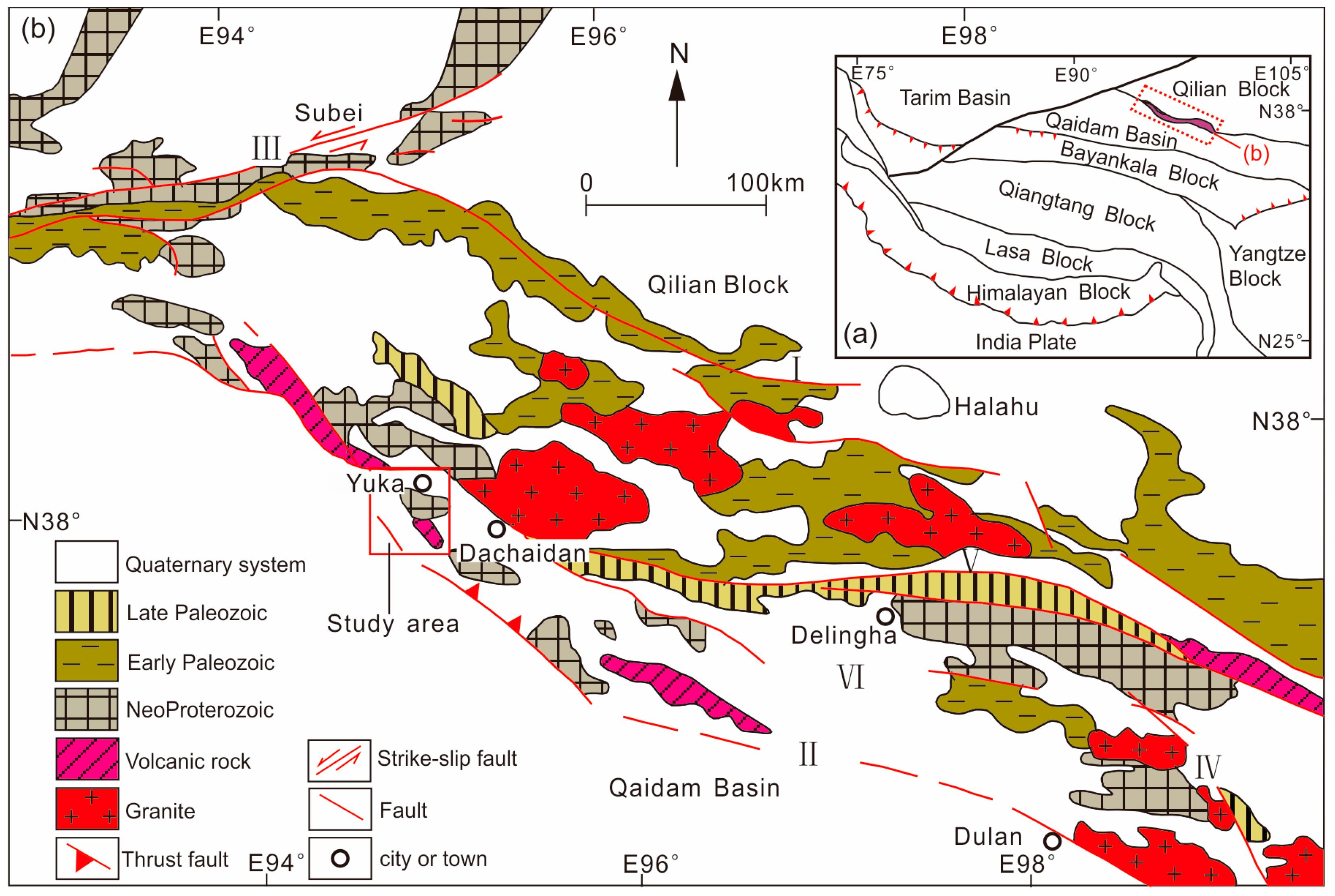
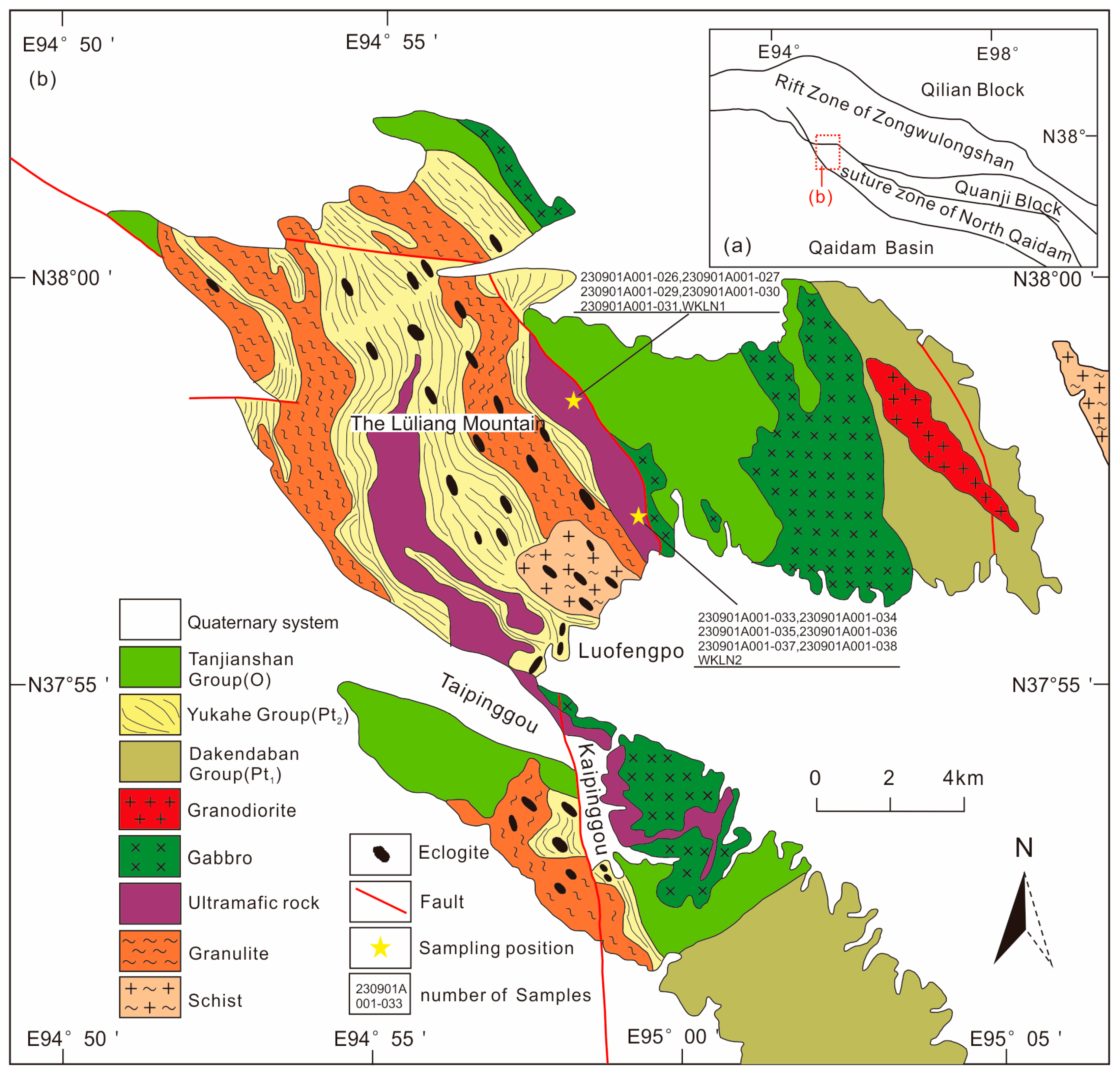
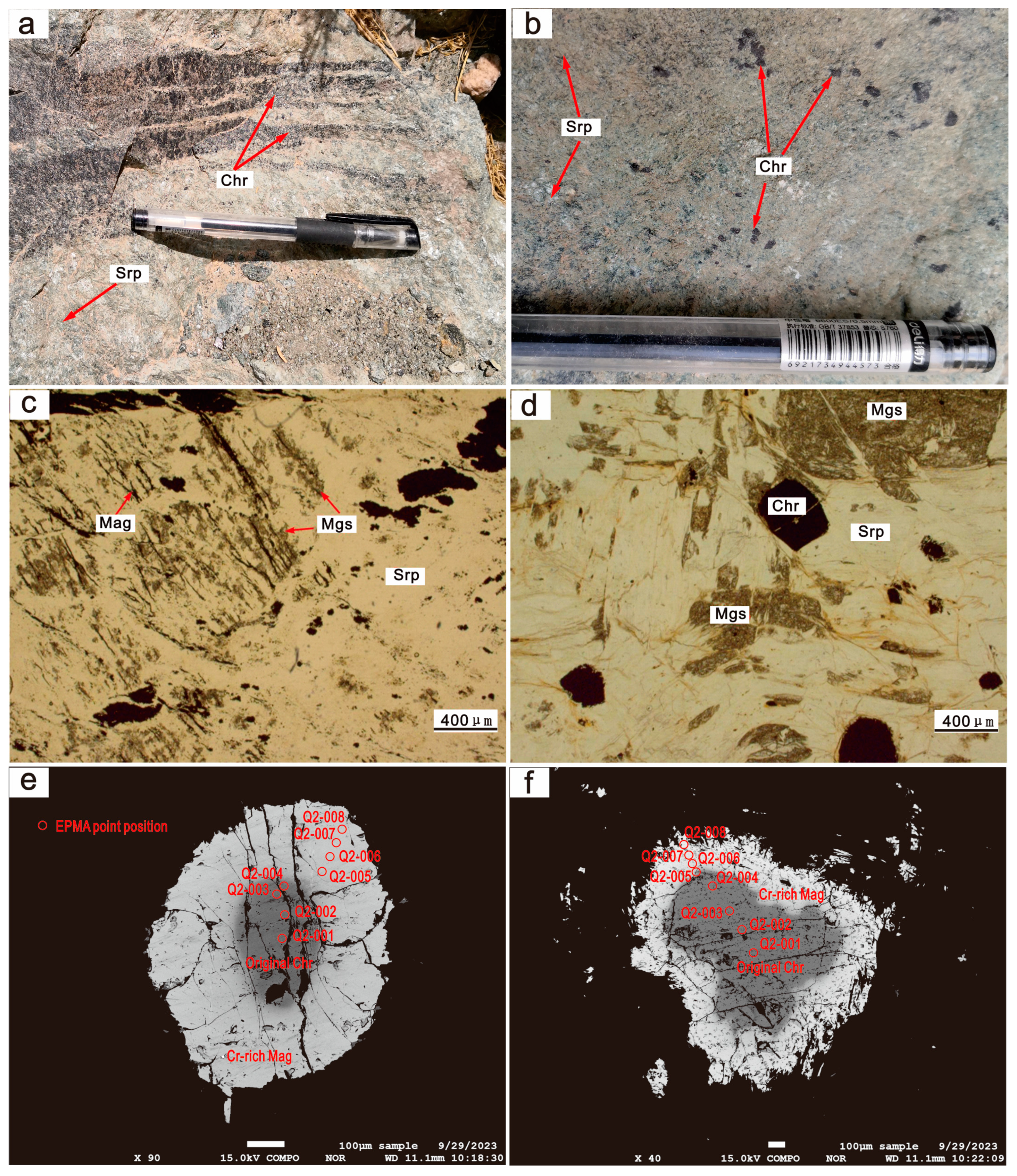
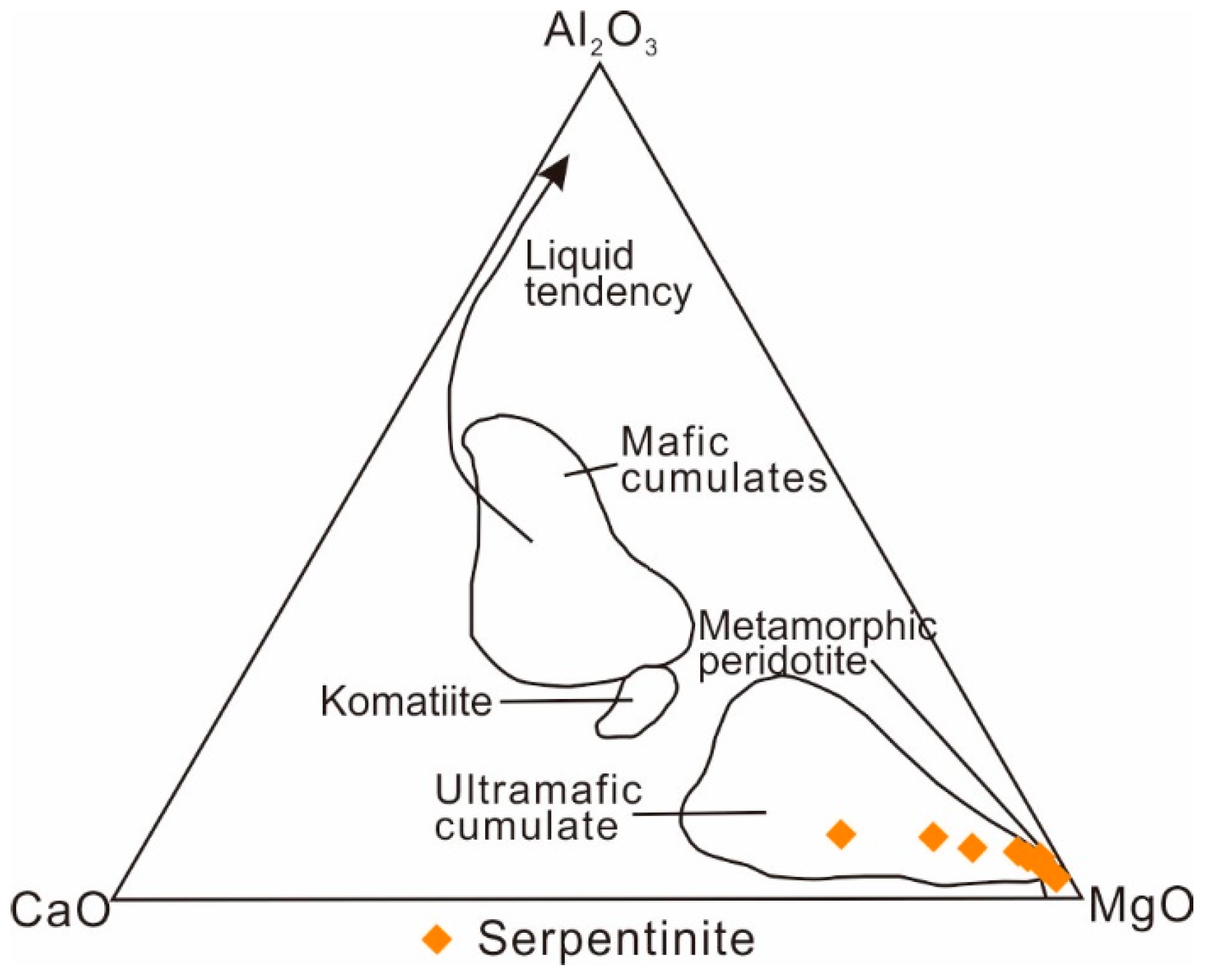
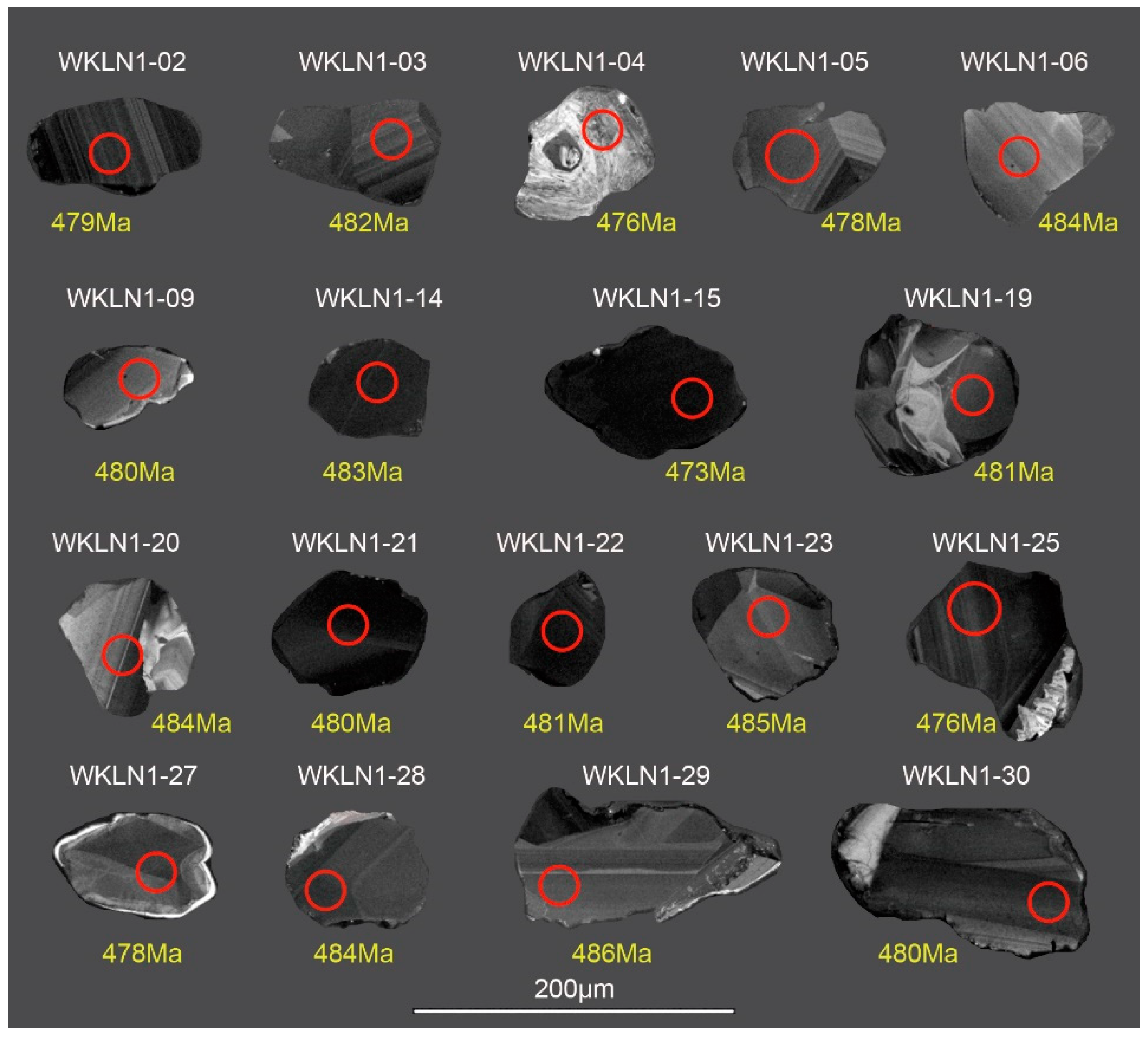

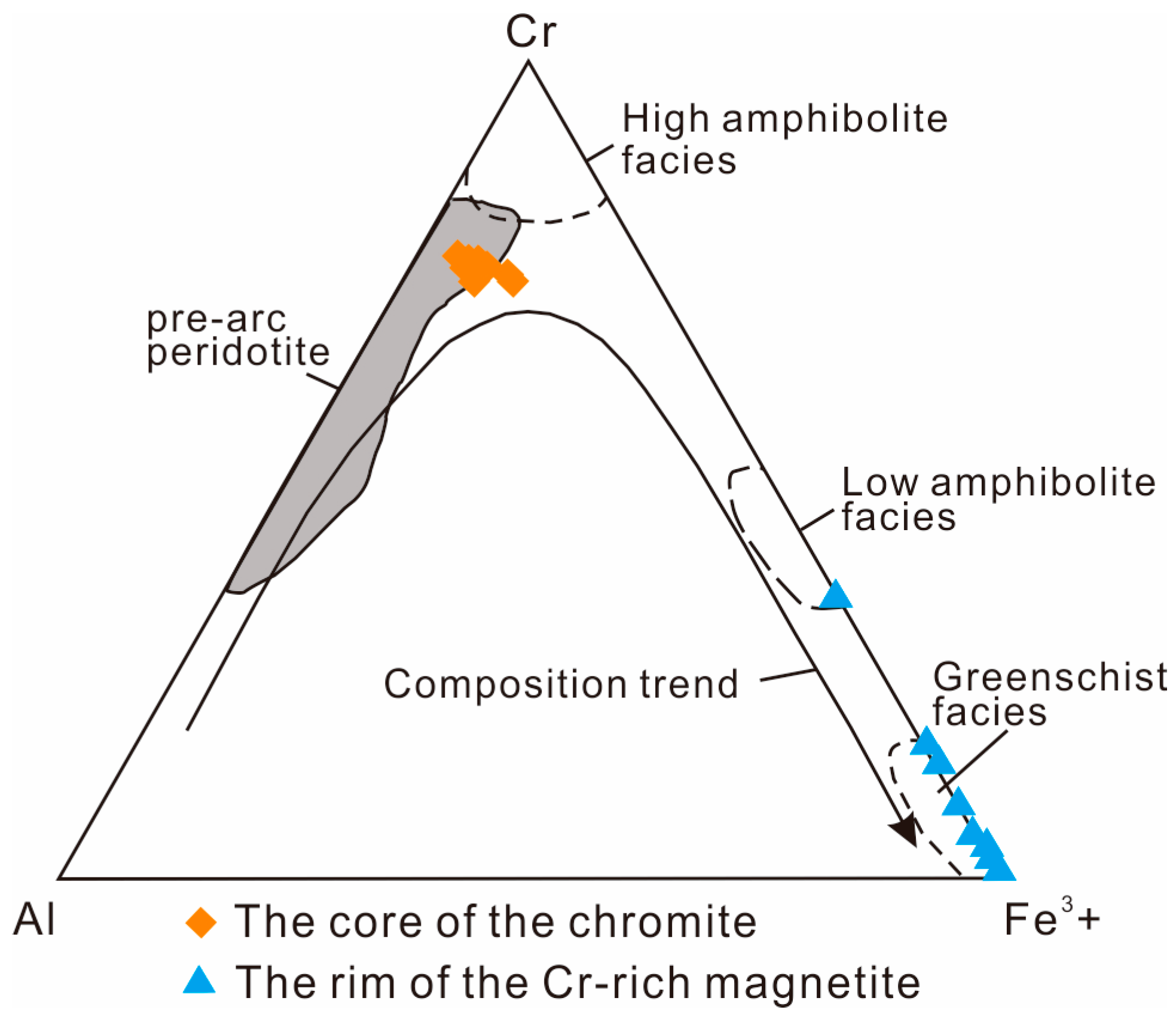
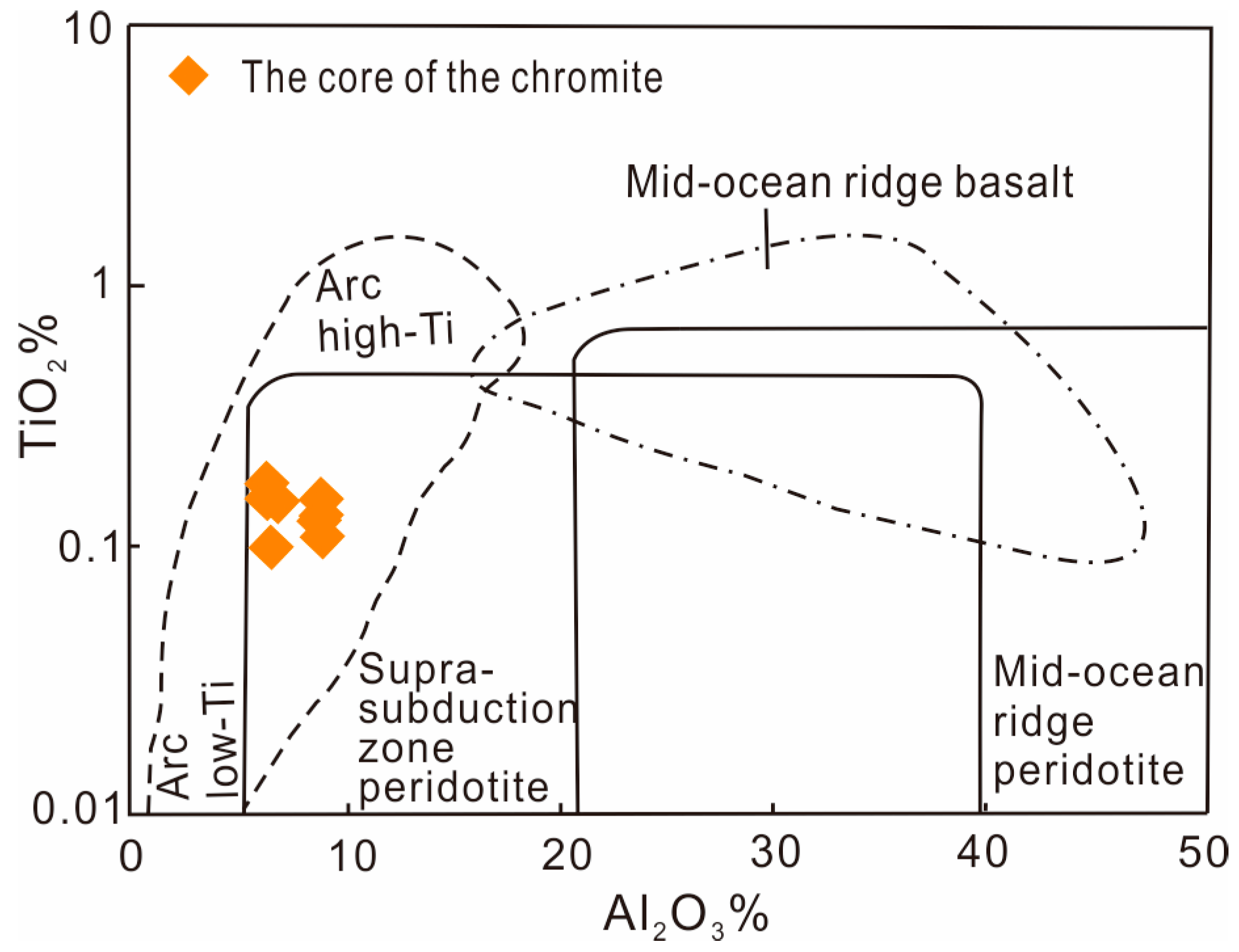
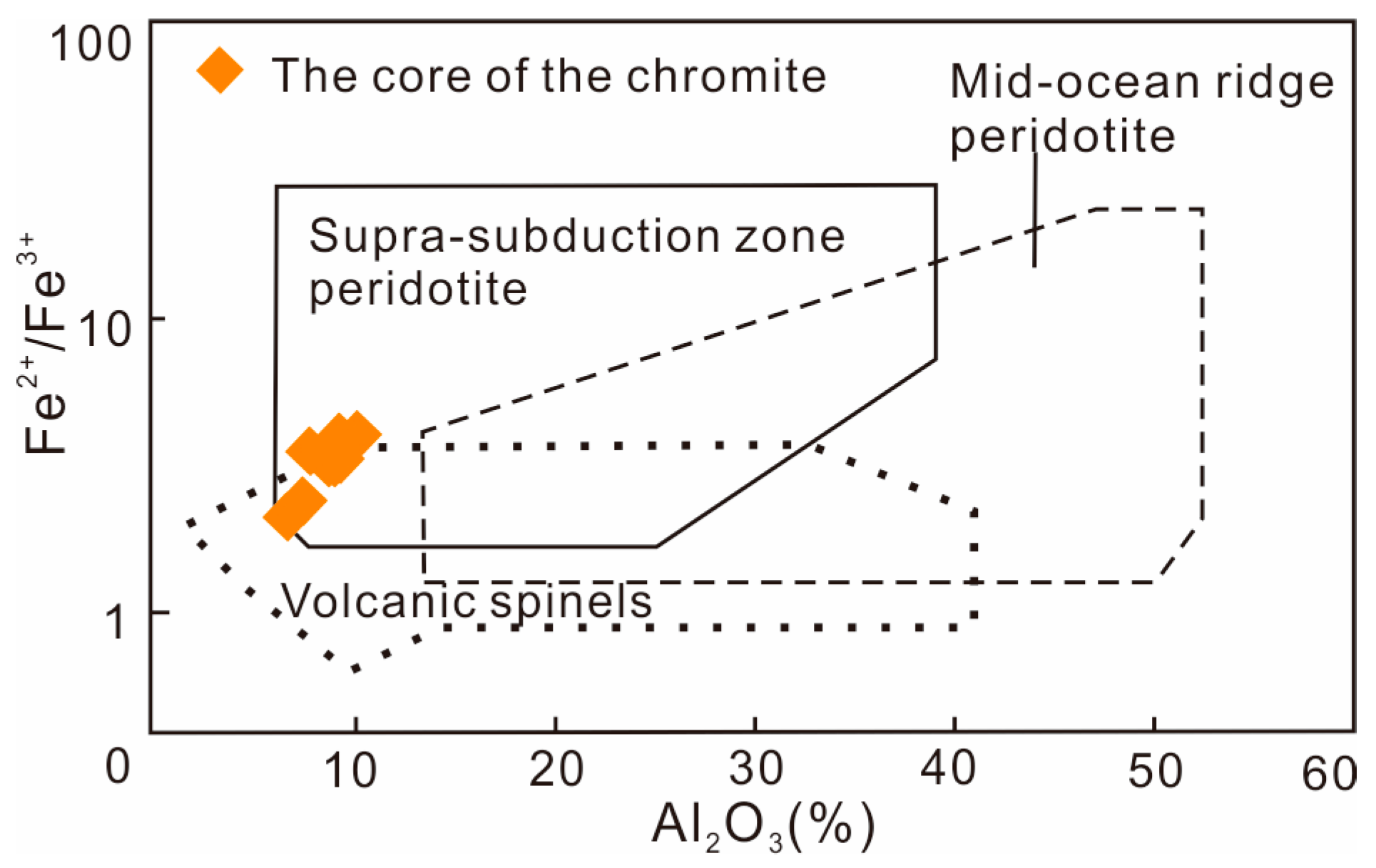
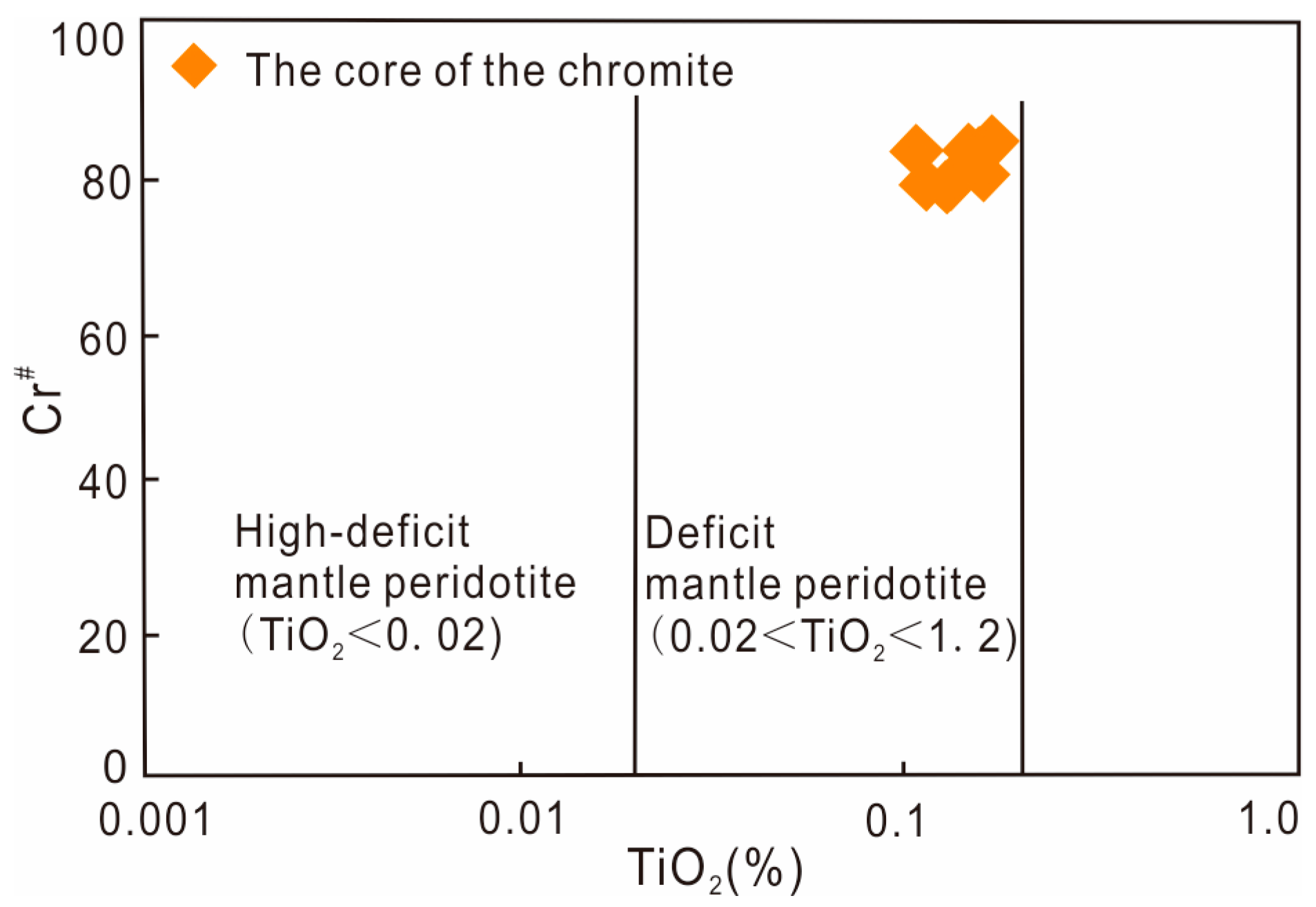
| Sample | 230901A 001-026 | 230901A 001-027 | 230901A 001-029 | 230901A 001-030 | 230901A 001-031 | 230901A 001-033 | 230901A 001-034 | 230901A 001-035 | 230901A 001-036 | 230901A 001-037 | 230901A 001-038 |
|---|---|---|---|---|---|---|---|---|---|---|---|
| SiO2 | 38.0 | 39.8 | 40.8 | 39.5 | 42.14 | 44.1 | 41.8 | 39.8 | 37.6 | 37.2 | 38.2 |
| TiO2 | 0.09 | 0.02 | 0.04 | 0.02 | 0.06 | 0.16 | 0.28 | 0.02 | 0.02 | 0.02 | 0.02 |
| Al2O3 | 2.32 | 0.33 | 0.94 | 1.07 | 1.97 | 2.66 | 2.31 | 0.47 | 0.44 | 0.34 | 0.35 |
| Fe2O3 | 8.33 | 6.28 | 6.00 | 6.43 | 4.91 | 3.87 | 5.01 | 6.42 | 5.44 | 5.38 | 5.82 |
| FeO | 0.54 | 0.49 | 2.23 | 1.81 | 4.23 | 3.01 | 3.74 | 1.02 | 0.95 | 1.48 | 1.10 |
| MnO | 0.14 | 0.05 | 0.08 | 0.13 | 0.11 | 0.17 | 0.17 | 0.04 | 0.09 | 0.08 | 0.06 |
| MgO | 39.1 | 39.4 | 36.8 | 38.5 | 34.4 | 31.8 | 33.3 | 39.7 | 39.9 | 40.1 | 40.1 |
| CaO | 0.22 | 0.40 | 0.57 | 0.21 | 1.18 | 4.37 | 2.84 | 0.08 | 0.10 | 0.07 | 0.06 |
| Na2O | 0.06 | 0.05 | 0.05 | 0.05 | 0.07 | 0.26 | 0.15 | 0.13 | 0.13 | 0.21 | 0.12 |
| K2O | 0.09 | 0.00 | 0.00 | 0.01 | 0.03 | 0.04 | 0.02 | 0.01 | 0.01 | 0.00 | 0.00 |
| P2O5 | 0.02 | 0.01 | 0.03 | 0.01 | 0.03 | 0.08 | 0.33 | 0.01 | 0.01 | 0.01 | 0.01 |
| LOI | 10.9 | 12.7 | 12. | 12.13 | 10.7 | 9.22 | 9.87 | 12.2 | 15.2 | 15.1 | 14.0 |
| Total | 99.75 | 99.61 | 99.86 | 99.87 | 99.80 | 99.74 | 99.77 | 99.88 | 99.88 | 99.99 | 99.83 |
| Point Number | Pb * | Th | U | Th/U | Isotope Ratio | Ages (Ma) | ||||||||||
|---|---|---|---|---|---|---|---|---|---|---|---|---|---|---|---|---|
| ppm | ppm | ppm | 207Pb/206Pb | 1σ | 207Pb/235U | 1σ | 206Pb/238U | 1σ | 207Pb/206Pb | 1σ | 207Pb/235U | 1σ | 206Pb/238U | 1σ | ||
| WKLN1-02 | 65 | 396 | 592 | 0.668 | 0.05712 | 0.0011 | 0.6075 | 0.01176 | 0.07713 | 0.00087 | 496 | 24 | 482 | 7 | 479 | 5 |
| WKLN1-03 | 56 | 272 | 522 | 0.52 | 0.05676 | 0.00105 | 0.60711 | 0.01123 | 0.07757 | 0.00087 | 482 | 22 | 482 | 7 | 482 | 5 |
| WKLN1-04 | 23 | 17 | 277 | 0.062 | 0.05693 | 0.00213 | 0.60115 | 0.02212 | 0.07658 | 0.00104 | 489 | 57 | 478 | 14 | 476 | 6 |
| WKLN1-05 | 76 | 167 | 848 | 0.197 | 0.05727 | 0.00103 | 0.60729 | 0.01102 | 0.0769 | 0.00086 | 502 | 21 | 482 | 7 | 478 | 5 |
| WKLN1-06 | 43 | 74 | 445 | 0.166 | 0.05613 | 0.00109 | 0.60309 | 0.01177 | 0.07793 | 0.00088 | 458 | 24 | 479 | 7 | 484 | 5 |
| WKLN1-09 | 97 | 141 | 1008 | 0.14 | 0.05723 | 0.00091 | 0.61004 | 0.00979 | 0.07731 | 0.00085 | 500 | 18 | 484 | 6 | 480 | 5 |
| WKLN1-14 | 124 | 401 | 1221 | 0.328 | 0.05744 | 0.00078 | 0.61636 | 0.00856 | 0.07782 | 0.00084 | 508 | 14 | 488 | 5 | 483 | 5 |
| WKLN1-15 | 97 | 150 | 1001 | 0.15 | 0.05908 | 0.00112 | 0.62059 | 0.01182 | 0.07618 | 0.00086 | 570 | 23 | 490 | 7 | 473 | 5 |
| WKLN1-19 | 28 | 28 | 302 | 0.094 | 0.05709 | 0.00127 | 0.60986 | 0.01352 | 0.07748 | 0.0009 | 495 | 29 | 483 | 9 | 481 | 5 |
| WKLN1-20 | 53 | 26 | 531 | 0.049 | 0.05742 | 0.00094 | 0.61743 | 0.01023 | 0.07797 | 0.00086 | 508 | 18 | 488 | 6 | 484 | 5 |
| WKLN1-21 | 50 | 189 | 505 | 0.375 | 0.05709 | 0.00099 | 0.60863 | 0.01064 | 0.07732 | 0.00086 | 495 | 20 | 483 | 7 | 480 | 5 |
| WKLN1-22 | 80 | 122 | 860 | 0.141 | 0.05706 | 0.00086 | 0.60901 | 0.00935 | 0.07741 | 0.00085 | 494 | 16 | 483 | 6 | 481 | 5 |
| WKLN1-23 | 28 | 14 | 312 | 0.045 | 0.05684 | 0.00173 | 0.61184 | 0.0183 | 0.07806 | 0.00098 | 485 | 44 | 485 | 12 | 485 | 6 |
| WKLN1-25 | 55 | 101 | 603 | 0.167 | 0.05877 | 0.00113 | 0.62163 | 0.01199 | 0.07671 | 0.00087 | 559 | 23 | 491 | 8 | 476 | 5 |
| WKLN1-27 | 38 | 73 | 430 | 0.169 | 0.057 | 0.00153 | 0.60527 | 0.01608 | 0.07701 | 0.00094 | 492 | 37 | 481 | 10 | 478 | 6 |
| WKLN1-28 | 49 | 105 | 527 | 0.198 | 0.05693 | 0.00106 | 0.61209 | 0.01145 | 0.07797 | 0.00088 | 489 | 22 | 485 | 7 | 484 | 5 |
| WKLN1-29 | 41 | 32 | 454 | 0.07 | 0.05625 | 0.00107 | 0.60692 | 0.01157 | 0.07824 | 0.00088 | 462 | 23 | 482 | 7 | 486 | 5 |
| WKLN1-30 | 22 | 16 | 253 | 0.064 | 0.05612 | 0.00278 | 0.59841 | 0.02901 | 0.07733 | 0.00121 | 457 | 80 | 476 | 18 | 480 | 7 |
| Point Number | WKLTZ1- Q2-001 | WKLTZ1- Q2-002 | WKLTZ1- Q2-003 | WKLTZ1- Q2-004 | WKLTZ2- Q2-001 | WKLTZ2- Q2-002 | WKLTZ2- Q2-003 | WKLTZ2- Q2-004 |
|---|---|---|---|---|---|---|---|---|
| CaO | 0.00 | 0.01 | 0.04 | 0.01 | 0.03 | 0.00 | 0.00 | 0.00 |
| TiO2 | 0.17 | 0.11 | 0.15 | 0.17 | 0.15 | 0.14 | 0.12 | 0.12 |
| Na2O | 0.02 | 0.06 | 0.08 | 0.04 | 0.02 | 0.03 | 0.03 | 0.02 |
| MgO | 2.81 | 2.83 | 2.66 | 2.23 | 4.63 | 4.54 | 4.24 | 4.04 |
| Cr2O3 | 52.19 | 52.02 | 51.64 | 51.81 | 53.72 | 53.50 | 53.65 | 53.16 |
| MnO | 1.39 | 1.47 | 1.54 | 1.65 | 1.38 | 1.48 | 1.55 | 2.09 |
| Fe2O3 | 7.72 | 8.41 | 8.64 | 8.74 | 5.46 | 5.45 | 5.19 | 5.71 |
| FeO | 26.94 | 26.92 | 27.17 | 27.80 | 24.90 | 24.95 | 25.27 | 24.99 |
| SiO2 | 0.02 | 0.03 | 0.01 | 0.00 | 0.03 | 0.02 | 0.02 | 0.00 |
| Al2O3 | 6.91 | 6.82 | 6.96 | 6.70 | 9.04 | 9.20 | 9.16 | 9.05 |
| K2O | 0.00 | 0.01 | 0.00 | 0.00 | 0.00 | 0.00 | 0.00 | 0.00 |
| Total | 98.17 | 98.67 | 98.90 | 99.15 | 99.35 | 99.32 | 99.23 | 99.18 |
| Oxygen | 4 | 4 | 4 | 4 | 4 | 4 | 4 | 4 |
| Ca | 0.00 | 0.00 | 0.00 | 0.00 | 0.00 | 0.00 | 0.00 | 0.00 |
| Ti | 0.00 | 0.00 | 0.00 | 0.00 | 0.00 | 0.00 | 0.00 | 0.00 |
| Na | 0.00 | 0.00 | 0.01 | 0.00 | 0.00 | 0.00 | 0.00 | 0.00 |
| Mg | 0.15 | 0.15 | 0.14 | 0.12 | 0.24 | 0.24 | 0.22 | 0.21 |
| Cr | 1.49 | 1.47 | 1.46 | 1.47 | 1.48 | 1.47 | 1.48 | 1.47 |
| Mn | 0.04 | 0.04 | 0.05 | 0.05 | 0.04 | 0.04 | 0.05 | 0.06 |
| Fe3+ | 0.21 | 0.23 | 0.23 | 0.24 | 0.14 | 0.14 | 0.14 | 0.15 |
| Fe2+ | 0.81 | 0.81 | 0.81 | 0.83 | 0.72 | 0.73 | 0.74 | 0.73 |
| Si | 0.00 | 0.00 | 0.00 | 0.00 | 0.00 | 0.00 | 0.00 | 0.00 |
| Al | 0.29 | 0.29 | 0.29 | 0.28 | 0.37 | 0.38 | 0.38 | 0.37 |
| K | 0.00 | 0.00 | 0.00 | 0.00 | 0.00 | 0.00 | 0.00 | 0.00 |
| sum | 3 | 3 | 3 | 3 | 3 | 3 | 3 | 3 |
| Cr# | 0.84 | 0.84 | 0.83 | 0.84 | 0.80 | 0.80 | 0.80 | 0.80 |
| Mg# | 0.16 | 0.16 | 0.15 | 0.13 | 0.25 | 0.25 | 0.23 | 0.22 |
| Fe3+# | 0.11 | 0.11 | 0.12 | 0.12 | 0.07 | 0.07 | 0.07 | 0.08 |
| Fe2+# | 0.84 | 0.84 | 0.85 | 0.87 | 0.75 | 0.75 | 0.77 | 0.78 |
| Point Number | WKLTZ1- Q2-005 | WKLTZ1- Q2-006 | WKLTZ1- Q2-007 | WKLTZ1- Q2-008 | WKLTZ2- Q2-005 | WKLTZ2- Q2-006 | WKLTZ2- Q2-007 | WKLTZ2- Q2-008 |
|---|---|---|---|---|---|---|---|---|
| CaO | 0.00 | 0.00 | 0.01 | 0.00 | 0.03 | 0.02 | 0.02 | 0.04 |
| TiO2 | 0.22 | 0.14 | 0.07 | 0.06 | 0.40 | 0.21 | 0.07 | 0.02 |
| Na2O | 0.00 | 0.00 | 0.02 | 0.02 | 0.03 | 0.03 | 0.05 | 0.00 |
| MgO | 0.19 | 0.18 | 0.13 | 0.11 | 0.97 | 0.57 | 0.33 | 0.15 |
| Cr2O3 | 11.13 | 6.42 | 4.27 | 1.99 | 23.59 | 9.66 | 2.90 | 0.18 |
| MnO | 0.52 | 0.19 | 0.04 | 0.03 | 2.23 | 0.87 | 0.13 | 0.11 |
| Fe2O3 | 57.30 | 62.88 | 64.28 | 67.07 | 44.94 | 59.40 | 66.61 | 68.92 |
| FeO | 30.72 | 31.14 | 30.92 | 31.15 | 28.25 | 29.81 | 30.74 | 30.86 |
| SiO2 | 0.06 | 0.03 | 0.05 | 0.06 | 0.06 | 0.01 | 0.00 | 0.04 |
| Al2O3 | 0.02 | 0.00 | 0.00 | 0.03 | 0.02 | 0.03 | 0.00 | 0.01 |
| K2O | 0.00 | 0.00 | 0.00 | 0.00 | 0.00 | 0.00 | 0.00 | 0.00 |
| Total | 100.17 | 100.98 | 99.79 | 100.52 | 100.52 | 100.62 | 100.83 | 100.34 |
| Oxygen | 4 | 4 | 4 | 4 | 4 | 4 | 4 | 4 |
| Ca | 0.00 | 0.00 | 0.00 | 0.00 | 0.00 | 0.00 | 0.00 | 0.00 |
| Ti | 0.01 | 0.00 | 0.00 | 0.00 | 0.01 | 0.01 | 0.00 | 0.00 |
| Na | 0.00 | 0.00 | 0.00 | 0.00 | 0.00 | 0.00 | 0.00 | 0.00 |
| Mg | 0.01 | 0.01 | 0.01 | 0.01 | 0.05 | 0.03 | 0.02 | 0.01 |
| Cr | 0.34 | 0.19 | 0.13 | 0.06 | 0.70 | 0.29 | 0.09 | 0.01 |
| Mn | 0.02 | 0.01 | 0.00 | 0.00 | 0.07 | 0.03 | 0.00 | 0.00 |
| Fe3+ | 1.65 | 1.80 | 1.86 | 1.93 | 1.27 | 1.69 | 1.91 | 1.99 |
| Fe2+ | 0.98 | 0.99 | 0.99 | 1.00 | 0.89 | 0.94 | 0.98 | 0.99 |
| Si | 0.00 | 0.00 | 0.00 | 0.00 | 0.00 | 0.00 | 0.00 | 0.00 |
| Al | 0.00 | 0.00 | 0.00 | 0.00 | 0.00 | 0.00 | 0.00 | 0.00 |
| K | 0.00 | 0.00 | 0.00 | 0.00 | 0.00 | 0.00 | 0.00 | 0.00 |
| sum | 3 | 3 | 3 | 3 | 3 | 3 | 3 | 3 |
| Cr# | 1.00 | 1.00 | 1.00 | 0.98 | 1.00 | 1.00 | 1.00 | 0.90 |
| Mg# | 0.01 | 0.01 | 0.01 | 0.01 | 0.06 | 0.03 | 0.02 | 0.01 |
| Fe3+# | 0.83 | 0.90 | 0.93 | 0.97 | 0.64 | 0.85 | 0.96 | 1.00 |
| Fe2+# | 0.99 | 0.99 | 0.99 | 0.99 | 0.94 | 0.97 | 0.98 | 0.99 |
| Point Number | The Crystallization Temperature of the Chromite | The Crystallization Pressure of the Chromite | ||||
|---|---|---|---|---|---|---|
| Ink | T (°C) | P (Gpa) | ||||
| WKLTZ1-Q2-001 | 0.747 | 0.932 | 1303.37 | 0.495 | 0.070 | 3.45 |
| WKLTZ1-Q2-002 | 0.741 | 0.922 | 1305.77 | 0.491 | 0.076 | 3.45 |
| WKLTZ1-Q2-003 | 0.735 | 0.913 | 1308.07 | 0.487 | 0.078 | 3.44 |
| WKLTZ1-Q2-004 | 0.739 | 0.919 | 1306.63 | 0.490 | 0.079 | 3.46 |
| WKLTZ2-Q2-001 | 0.742 | 0.924 | 1305.37 | 0.492 | 0.048 | 3.38 |
| WKLTZ2-Q2-002 | 0.739 | 0.919 | 1306.59 | 0.490 | 0.047 | 3.37 |
| WKLTZ2-Q2-003 | 0.743 | 0.925 | 1305.15 | 0.493 | 0.045 | 3.37 |
| WKLTZ2-Q2-004 | 0.737 | 0.916 | 1307.20 | 0.490 | 0.050 | 3.38 |
| Range | 0.735–0.747 | 0.913–0.932 | 1303.37–1308.07 | 0.487–0.495 | 0.045–0.079 | 3.37–3.46 |
| Average | 0.740 | 0.921 | 1306.02 | 0.491 | 0.062 | 3.41 |
Disclaimer/Publisher’s Note: The statements, opinions and data contained in all publications are solely those of the individual author(s) and contributor(s) and not of MDPI and/or the editor(s). MDPI and/or the editor(s) disclaim responsibility for any injury to people or property resulting from any ideas, methods, instructions or products referred to in the content. |
© 2024 by the authors. Licensee MDPI, Basel, Switzerland. This article is an open access article distributed under the terms and conditions of the Creative Commons Attribution (CC BY) license (https://creativecommons.org/licenses/by/4.0/).
Share and Cite
Guo, H.; Li, Y.; Chen, B.; Zhang, H.; Yang, X.; He, L.; Ma, Y.; Li, Y.; Luo, J.; Zhao, H. The Genesis of Ultramafic Rock Mass on the Northern Slope of Lüliang Mountain in North Qaidam, China. Minerals 2024, 14, 871. https://doi.org/10.3390/min14090871
Guo H, Li Y, Chen B, Zhang H, Yang X, He L, Ma Y, Li Y, Luo J, Zhao H. The Genesis of Ultramafic Rock Mass on the Northern Slope of Lüliang Mountain in North Qaidam, China. Minerals. 2024; 14(9):871. https://doi.org/10.3390/min14090871
Chicago/Turabian StyleGuo, Haiming, Yanguang Li, Bo Chen, Huishan Zhang, Xiaoyong Yang, Li He, Yongjiu Ma, Yunping Li, Jincheng Luo, and Haichao Zhao. 2024. "The Genesis of Ultramafic Rock Mass on the Northern Slope of Lüliang Mountain in North Qaidam, China" Minerals 14, no. 9: 871. https://doi.org/10.3390/min14090871
APA StyleGuo, H., Li, Y., Chen, B., Zhang, H., Yang, X., He, L., Ma, Y., Li, Y., Luo, J., & Zhao, H. (2024). The Genesis of Ultramafic Rock Mass on the Northern Slope of Lüliang Mountain in North Qaidam, China. Minerals, 14(9), 871. https://doi.org/10.3390/min14090871





